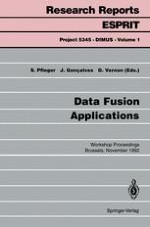Data fusion, the ability to combine data derived from several sources to provide a coherent, informative, and useful characterization of a situation,is a challenging task. There is no unified and proven solution which is applicable in all circumstances, but there are many plausible and useful approaches which can be and are used to solve particular applications. This volume presents the proceedings of the workshop Data Fusion Applications hosted in Brussels by the 1992 ESPRIT Conference and Exhibition. It contains 22 papers from 69 experts,who present advanced research results on data fusion together with practicalsolutions to multisensor data fusion in a wide variety of applications: real-time expert systems, robotics, medical diagnosis and patient surveillance, monitoring and control, marine protection, surveillance and safety in public transportation systems, image processing and interpretation, and environmental monitoring. The research forms part of the ESPRIT project DIMUS (Data Integration in Multisensor Systems).
